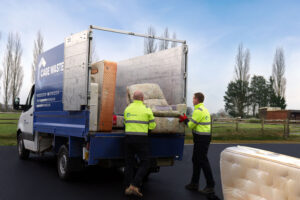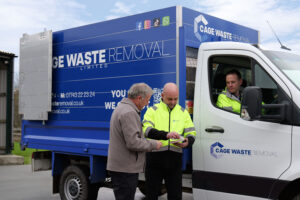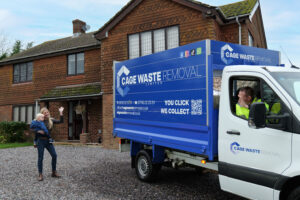Plasterboard Recycling
Plasterboard recycling refers to the process of recovering materials from waste plasterboard (also known as drywall or gypsum board) to be reused in the production of new plasterboard or other products. Given that plasterboard is widely used in construction, recycling is an important method for reducing landfill waste and conserving resources.
While there are challenges such as contamination, the environmental and economic benefits of recycling plasterboard make it an important part of sustainable building practices.
Ultimately, recycling plasterboard is not only an environmentally responsible practice but also an opportunity to create a more sustainable construction industry, reduce waste, and conserve valuable resources for future generations.
Why Recycle Plasterboard?
- Waste Reduction: Plasterboard accounts for a significant portion of construction and demolition (C&D) waste. Recycling helps divert this waste from landfills, reducing environmental impact.
- Resource Conservation: Plasterboard is primarily made of gypsum, which is a natural mineral. By recycling, the need for extracting raw gypsum from quarries is reduced, conserving natural resources.
- Energy Efficiency: Manufacturing new plasterboard from recycled gypsum uses less energy compared to producing it from virgin materials.
- Environmental Impact: Gypsum in landfills can release harmful hydrogen sulfide gas as it decomposes, contributing to environmental pollution. Recycling helps mitigate this.
Benefits of Plasterboard Recycling
- Environmental Sustainability: Recycling reduces the environmental impact of mining gypsum and the volume of plasterboard waste that ends up in landfills.
- Resource Efficiency: Recycled gypsum can be used in the production of new plasterboard, saving on raw materials and reducing energy use in manufacturing..
Plasterboard Recycling Process
- Collection and Sorting: Waste plasterboard is collected should be kept separate from other construction waste materials such as wood, metal, or concrete.
- Shredding: The collected plasterboard is shredded into smaller pieces to break it down into a manageable form. This helps to separate the gypsum core from the paper lining.
- Separation: The next step involves separating the paper liner from the gypsum core. The paper can be recycled separately, while the gypsum is processed for reuse.
- In some cases, the gypsum can be treated with water to create a slurry, which can be dried and reused in new products.
Ready to Clear Your Waste?
Don’t let waste pile up! Reach out to Cage Waste Removal for efficient and eco-friendly waste management solutions. Contact us now to schedule your same-day service and experience the difference.
Why Choose Our Services

Sustainable Practices
All collected waste is processed with a focus on recycling and reducing landfill contributions, supporting a healthier planet.

Full Traceability
Track your waste from collection to disposal, ensuring transparency and accountability in our processes.

Customized Solutions
Our services are adaptable to meet the unique needs of each client, providing personalized waste management strategies.
What Our Customers Say
★★★★★
"Cage Waste Removal exceeded my expectations with their prompt and efficient service. Their commitment to sustainability is truly commendable."
Jane Hawthorn
Local Business Owner
★★★★★
"I have been using Cage Waste Removal for over a year now, and their professionalism and reliability are unmatched. Highly recommended!"
John Smith
Homeowner
★★★★★
"The team at Cage Waste Removal is fantastic! They made the entire process hassle-free, and I love that they prioritize eco-friendly practices."
Emily Brown
Environmental Consultant
Get Your Free Quote Today!
Experience a seamless waste removal service with Cage Waste Removal. Reach out to us for a free quote or to schedule your service today, and enjoy a hassle-free experience that prioritises sustainability and efficiency. Let us take care of your waste needs while you focus on what matters most.
Plasterboard Recycling Collection Services
In our mission at Cage Waste Removal to work towards a zero waste future, we recognise the vital role of recycling plasterboard in promoting sustainability and reducing landfill waste. Plasterboard, a common material in construction and renovation, often finds its way to disposal sites, contributing significantly to environmental harm. However, through proper recycling practices, we can transform this hazardous trend into an opportunity for positive change.
Recycling plasterboard not only conserves natural resources but also reduces greenhouse gas emissions associated with manufacturing new products. When plasterboard is recycled, it can be transformed into new plaster products or used in the production of cement, effectively closing the loop of resource utilisation. This process not only diminishes the demand for virgin materials but also supports a circular economy where waste is turned into valuable resources.
At Cage Waste Removal, our commitment to responsible waste management extends to ensuring that your plasterboard waste is handled in an environmentally conscious manner. We offer convenient collection services that prioritise the recycling of this material, ensuring it doesn’t end up in a landfill. Our team works diligently to separate and process plasterboard waste, collaborating with licensed recycling facilities that adhere to industry standards.
We understand that the construction and renovation sectors play a crucial role in the overall waste management landscape. By choosing to recycle plasterboard, businesses and homeowners can contribute to a more sustainable future while also complying with regulations that encourage responsible waste disposal. Our services are tailored to meet the specific needs of your project, allowing for seamless integration of eco-friendly practices into your build or renovation.
A solution for Plasterboard Recycling
As we continue to advocate for responsible waste practices, we urge you to consider the broader impact of your waste choices. Recycling plasterboard not only benefits the environment but also reflects a growing awareness and personal responsibility towards sustainability. With Cage Waste Removal, you can take confident strides towards reducing your carbon footprint, knowing that your plasterboard waste is in expert hands.
Join us in our campaign for a greener tomorrow. When you choose to recycle plasterboard with Cage Waste Removal, you are making a significant contribution to the preservation of our planet. Together, we can reshape the future and turn waste into opportunity, fostering a culture where sustainability is at the forefront of our actions. The journey towards a zero waste future starts with us – let’s make every choice count.
